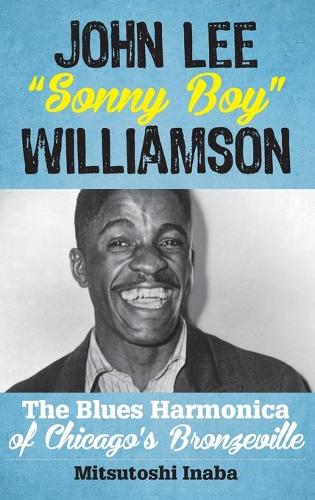
John Lee "Sonny Boy" Williamson: The Blues Harmonica of Chicago's Bronzeville
(Hardback)
Publishing Details
John Lee "Sonny Boy" Williamson: The Blues Harmonica of Chicago's Bronzeville
By (Author) Mitsutoshi Inaba
Bloomsbury Publishing PLC
Rowman & Littlefield Publishers
10th October 2016
United States
Classifications
General
Non Fiction
Popular music
Musicians, singers, bands and groups
Composers and songwriters
788.821643092
Physical Properties
Hardback
246
Width 157mm, Height 239mm, Spine 23mm
513g
Description
John Lee "Sonny Boy" Williamson was one of the most popular blues harmonica players and singers from the late 1930s through the 1940s. Recording for the Bluebird Records and RCA Victor labels, Sonny Boy shaped Chicago's music scene with an innovative style that gave structure and speed to blues harmonica performance. His recording in 1937 of "Good Morning, School Girl," followed by others made him a hit with Southern black audiences who had migrated north. Unfortunately, his popularity and recording career ended on June 1, 1948, when he was robbed and murdered in Chicago, Illinois. In 1980, he was inducted into the Blues Foundation Hall of Fame.
Mitsutoshi Inaba offers the first full-length biography of this key figure in the evolution of the Chicago blues. Taking readers through Sonny Boy's career, Inaba illustrates how Sonny Boy lived through the lineage of blues harmonica performance, drawing on established traditions and setting out a blueprint for the growing electric blues scene. Interviews with Sonny Boy's family members and his last harmonica student provide new insights into the character of the man as well as the techniques of the musician.
John Lee "Sonny Boy" Williamson: The Blues Harmonica of Chicago's Bronzeville provides fans and musicians alike an invaluable exploration of the life and legacy of one the Chicago blues' founding figures.
Reviews
Williamson, one of the well-known blues harmonica players and singers from the golden era of the blues, gets the royal treatment from musicologist Inaba, who elevates him as an American musical innovator. Williamson was born in 1914 and nicknamed Sonny Boy by his grandmother in his native Tennessee. When he was 11, his mother gave him a harmonica, sparking endless hours of practice until he could perform locally. Blues fans acknowledge Williamsons supreme talent on the blues harp, which was recorded in the 19371938 Aurora sessions and the 19381948 Chicago dates. When the singer joined the blues legends of the popular Bluebird Records in its glory days, his clever phrasing and dazzling harp technique sent his fans rushing to buy his more than 120 recorded sides for the Bluebird and RCA Victor labels. He also recorded a smash hit, 'Good Morning, School Girl,' in 1937. Inaba pays much attention to Williamsons drinking problem, womanizing, and reckless behavior leading to his murder in 1948maybe too much. Despite Williamsons flaws, Inaba confirms the prickly singer, who transformed down-home country blues into a unique up-tempo urban jump sound, as a genuine folk hero influential in one of Americas signature musical forms. * Publishers Weekly *
This one, originally started as a collaboration with Jim ONeal, is a very easy read indeed. It flows beautifully and sweeps the reader along effortlessly....The bibliography is impressively thorough. Heartily recommended. * Blues & Rhythm *
[A]uthor Mitsutoshi Inaba traces Williamsons life, providing in-depth examinations of subsequent recording sessions for more than 120 tracks that the harmonica cut during his short career. The author also takes a look at key sessions where Williamson provided backing for artists like Williams, Rachell, and Henry Townsend. There are also breakdowns of songs with tablature provided by the author, who learned how to play blues harmonica in order to better understand Williamsons style. Two key parts of the research for the book were provided by Jim ONeal, co-founder of Living Blues magazine and an early collaborator on the project. The unpublished interviews with T.W. Utley, Williamsons half brother, and Fred Utley, his uncle, contain information that allows Inaba to go beyond the music in developing his portrayal. Included in the book are twelve pages of b&w photos, extensive notes, and a complete discography of all the tracks Williamson cut under his name. If you have more than a passing interest in the blues harmonica legacy or want to broaden your knowledge about one of the key innovators of the music add this one to your reading list. * Blues Blast Magazine *
Mitsutoshi Inabas new biography of John Lee Williamsonthe first Sonny Boyis a must-have book not just for blues scholars, but for any serious student of the blues harmonica. Inaba has combined rich archival research and song-by-song analysis, including commentary by contemporary master Joe Filisko, into a vibrant portrait of the first star of the blues harp. I learned a lot from this study. Great work! -- Adam Gussow, blues harmonicist, University of Mississippi
Author Bio
Mitsutoshi Inaba holds a doctorate in musicology and ethnomusicology from the University of Oregon. He currently teaches courses on African American studies with a focus on music at Austin Peay State University in Clarksville, Tennessee. He is the author of Willie Dixon: Preacher of the Blues (2011).
